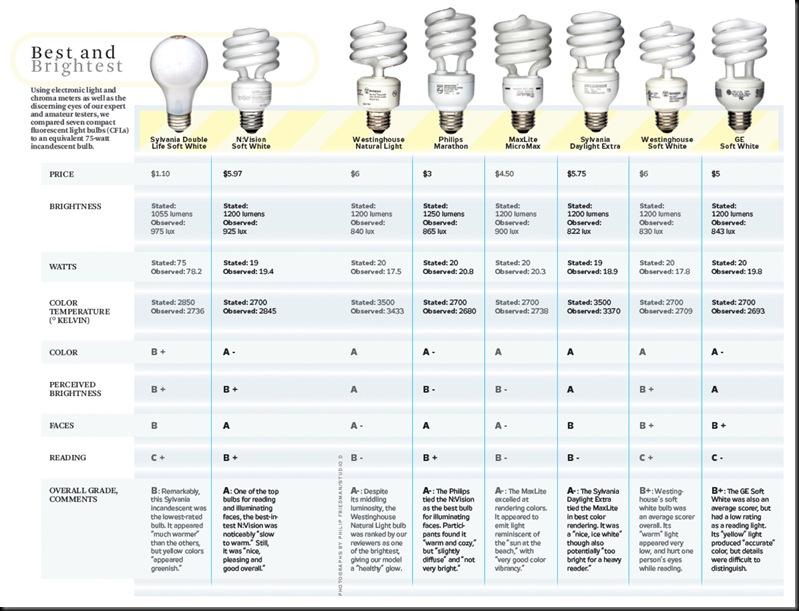1006 Morton Street
Baltimore, MD 21201
410.576.9131 | Email
December 21 2007
The Best Compact Fluorescent Light Bulbs
Can the new breed of energy-saving fluorescents hold their own against incandescents? Popular Mechanics ran seven bulbs through their optical course to find out.
The compact fluorescent light bulb revolution nearly occurred back in the early 1990s. When CFLs first hit the market in force, consumers bought them in large numbers ? but they hated them. The bulbs were too big for many fixtures, expensive (up to $25 each) and they threw a dim, antiseptic light that paled next to the warmth of good old-fashioned incandescent bulbs.
When it comes to illuminating your home, brightness isn?t everything. Can CFLs match the light quality of the energy-wasting incandescents we know and love?
Popular Mechanics designed a test pitting seven common CFLs against a 75-watt incandescent bulb. To gather objective data, we used a Konica Minolta CL-200 chroma meter to measure color temperature and brightness, and a Watts up? Pro ammeter to track power consumption. Our subjective data came from a double-blind test with three PM staffers and Jesse Smith, a lighting expert from Parsons The New School for Design, in Manhattan. We put our participants in a color-neutral room and asked them to examine colorful objects, faces and reading material, then rate the bulbs? performance.
The results surprised us. Even though the incandescent bulb measured slightly brighter than the equivalent CFLs, our subjects didn?t see any dramatic difference in brightness. And here was the real shocker: When it came to the overall quality of the light, all the CFLs scored higher than our incandescent control bulb. In other words, the new fluorescent bulbs aren?t just better for both your wallet and the environment, they produce better light.
CFL BACKGROUND
Color temperature: The lower the color temperature, the warmer the light. Warmness (red) or coolness (blue) can be measured in degrees Kelvin by a chroma meter. We observed a temperature of about 2700 K for soft white bulbs, whereas "daylight" bulbs measured around 3400 K ? real noontime sunlight ranges from 5000 K to 6500 K.
Lumens vs. lux: Manufacturers use a complex process to measure lumens, the total quantity of light emitted by a bulb. We used a light and chroma meter to measure lux, the light intensity a bulb shines on a surface. Our observed results in lux generally tracked with manufacturers? lumen ratings.
Watts and efficiency: Our ammeter?s CFL wattage results were all within 3 watts of manufacturer ratings ? but all CFLs use about 70 percent less electricity than incandescent bulbs. The average U.S. household has 45 light bulbs ? replacing that number of 75-watt incandescent bulbs with CFLs would save $180 per year.
Phosphor: This chemical compound lines the inside of CFL tubing. When excited, it converts ultraviolet radiation into visible light. The chemical composition of the phosphor determines the color temperature of the light emitted by the bulb.
Mercury: According to the EPA, CFLs contain an average of 5 milligrams of mercury, which increases the bulb?s efficiency. But that also means you can?t just trash them?CFLs must be properly recycled. Visit Energy Star or Earth 911 for disposal instructions.
Beyond Fluorescent with LEDs: Light emitting diodes (LEDs) are tiny yet powerful sources of light that are even more energy efficient than CFLs. Manufacturing LEDs that produce light equivalent to a 60-watt bulb is expensive, however. One bulb can cost as much as $75.
For more information please visit the
Popular Mechanics website.
Recent Posts
Reimagining Harborplace to Create Space for Both Private Development and Expanded Public Space » Lawyer's Mall Reconstruction Progress » Confronting the Conventions of Customary Practice » Reconceived Facades: New Roles for Old Buildings » Ivy Bookshop Opens for Business! »
Categories
Yellow Balloon Baltimore » Products + Technology » Industry + Practice » Other » Architecture »
Links
Organizations
- USGBC Baltimore Regional Chapter »
- AIA - American Institute of Architects »
- USGBC »
- The Walters Art Museum »
- Green-e »
- Center for Building Performance and Diagnostics (CMU) »
- Green Globes »
- Prefab Lab (UT) »
- Center for Sustainable Development (UT) »
- Architecture 2030 »
- Bioneers »
- Street Films »
- FreeCycle »
- Chesapeake Bay Foundation »
- Archinect »
- BD Online - The Architects Website »
- National Wildlife Foundation »
- Natural Resources Defense Council »
- Overbrook Foundation »
- Merck Family Foundation »
- Ecology Center »
- New Building Institute »
- Neighborhood Design Center »
- The Leonardo Academy »
- ZigerSnead Architects LLP »
- The Rocky Mountain Institute »
- Urban Habitats »
- ACORE - American Council on Renewable Energy »
- Parks and People Foundation of Baltimore »
- Open Society Institute of Baltimore »
- Natural Capital Institute »
- Passive House US »
- Svanen Miljomark »
- Green Restaurant Association »
- Rocky Mountain Institute »
- Green Exhibits »
- Green Roundtable »
- John Elkington - SustainAbility »
- SustainAbility »
- Building America »
- Endangered Species Program - Fish and Wildlife Service »
- Congress for the New Urbanism »
- Urban Land Institute »
- Cool Roof Rating Council »
- Montgomery County (MD) Public Schools Green Building Program »
- National Institute of Standards and Technology Software »
- Scientific Certification Systems »
- Community Greens »
- CBECS »
- CASE - Center for Architecture Science and Ecology »
Interesting Sites
- The Ecologist »
- Treehugger »
- Grist »
- WIRED »
- Planet Architecture »
- MiljoBloggAktuellt - Environmental News Blog (Swedish »
- Sustainable Design Update »
- Eikongraphia »
- World Architecture News »
- The Cool Hunter »
- Design Center »
- ZEDfactory »
- Architen Landrell Associates Ltd. »
- Environmental Graffiti »
- businessGreen »
- Best Green Blogs Directory »
- Groovy Green »
- EcoGeek »
- Urban Ecology »
- Locus Architecture »
- Urbanite »
- A Daily Dose of Architecture »
- Adaptive Reuse »
- Audacious Ideas »
- Big Green Me »
- NOTCOT »
- Sustainable Baltimore »
- Thoughts on Global Warming »
- Green Maven »
- WorldChanging »
- Go For Change »
- Building Green »
- Home Energy Magazine »
- Home Energy Blog »
- FEMA Map Service- Federal Emergency Management Association »
- Architectural Graphic Standards »
- E-Wire »
- Post Carbon Cities »
- Alt Dot Energy »
- Whole Building Design Guide »
- B'more Green »
- EJP: Environmental Justice Partnership »
- Baltidome »
- OneOffMag »


August 7th, 2008 at 2:32 PM
Rita
I am looking for some of those LED light bulbs so I can save some money. They are so cool, and they are good for the environment as well. I'm going to have to do some price comparisons online for them.